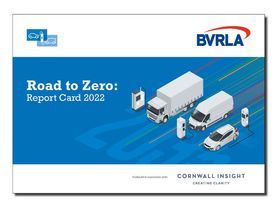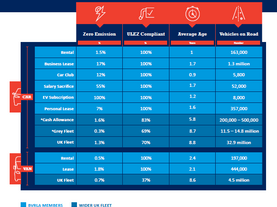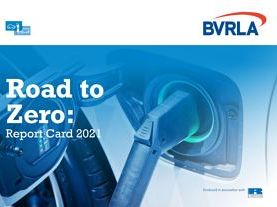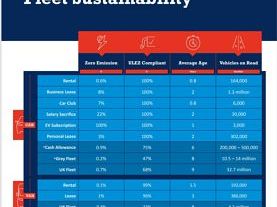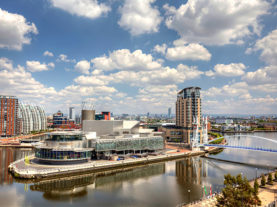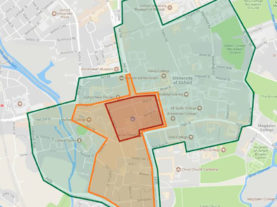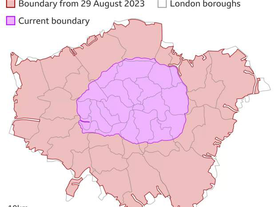Vehicle rental, leasing and car clubs offer flexible, affordable, Clean Air Zone-compliant vehicles for those driving within or through a zone.
100% of rented, leased and car club cars are Clean Air Zone (CAZ) and Ultra Low Emission Zone (ULEZ) compliant and 99% of rented vans (96% of leased vans) are as well, according to the latest Sustainability Credentials report. The figures are well ahead of the average for all UK cars, where only 68% meet ULEZ emission requirements.
Clean Air Zones FAQs
What is a Clean Air Zone?
In 2015 the Government released plans to improve air quality across the UK through a variety of measures, including the implementation of ‘Clean Air Zones’ (CAZ).
Cities with the most persistent air quality problems will apply restrictions to encourage only the cleanest vehicles to operate within the boundaries of their Clean Air Zone (CAZ). Any vehicle not meeting the specified emission standards will be required to pay a fee to operate within the boundaries of that CAZ.
Some cities are looking to go further and create Low Emission Zones or Zero Emission Zones where a total ban of non-compliant vehicles may instead be introduced.
Operation of CAZs
- The Zones will run 7 days a week, 24 hours a day.
- They will be enforced by a network of Automatic Number Plate Recognition (ANPR) cameras.
- Those vehicles liable to pay the charge would pay using the Government’s online portal.
- Discounts and exemptions will be put in place for some vehicle types. Some exemptions are temporary, some are permanent, and some are for vehicles licensed with certain local authority areas only. Check on the local authority site to get further information on exemptions and financial support available.
- There is a vehicle checker where you can check if you would need to pay the charge depending on which clean air zone you have travelled in. If you’re a business and want to check a number of vehicles you’ll need:
- an account - you can create one when you use this service
- your company name
- an email address
- a spreadsheet in CSV format of the number plates (registration numbers) of the vehicles you want to check
CAZ grades A, B, C and D explained
There are four grades of charging Clean Air Zones (CAZ) that local authorities can consider implementing, as set out in the Government’s national framework.
CAZ A
Has the fewest restrictions, and only charges buses, coaches, taxis and private hire vehicles.
Minimum standards required for compliance are listed below:
|
Vehicle type |
Compliance standards |
|
Buses |
Euro VI |
|
Coaches |
Euro VI |
|
Taxis |
Euro 6 (Diesel) Euro 4 (Petrol) |
|
Private Hire Vehicles |
Euro 6 (Diesel) Euro 4 (Petrol) |
CAZ B
Charges HGVs in addition to the vehicles listed for Class A.
Minimum standards required for compliance are listed below:
|
Vehicle type |
Compliance standards |
|
Buses |
Euro VI |
|
Coaches |
Euro VI |
|
Taxis |
Euro 6 (Diesel) Euro 4 (Petrol) |
|
Private hire vehicles |
Euro 6 (Diesel) Euro 4 (Petrol) |
|
HGVs |
Euro VI |
CAZ C
Charges LGVs in addition to all those listed for Class B.
Minimum standards required for compliance are listed below:
|
Vehicle type |
Compliance standards |
|
Buses |
Euro VI |
|
Coaches |
Euro VI |
|
Taxis |
Euro 6 (Diesel) Euro 4 (Petrol) |
|
Private hire vehicles |
Euro 6 (Diesel) Euro 4 (Petrol) |
|
HGVs |
Euro VI |
|
LGVs |
Euro 6 (Diesel) Euro 4 (Petrol) |
CAZ D
Charges cars in addition to all those listed for Class C.
Minimum standards required for compliance are listed below:
|
Vehicle type |
Compliance standards |
|
Buses |
Euro VI |
|
Coaches |
Euro VI |
|
Taxis |
Euro 6 (Diesel) Euro 4 (Petrol) |
|
Private hire vehicles |
Euro 6 (Diesel) Euro 4 (Petrol) |
|
HGVs |
Euro VI |
|
LGVs |
Euro 6 (Diesel) Euro 4 (Petrol) |
|
Cars |
Euro 6 (Diesel) Euro 4 (Petrol) |
|
Motorcycles and mopeds (optional) |
Euro 3 |
Do I need to pay to enter a CAZ?
You can use the Government's online portal to check whether your vehicle is going to be subject to charges to enter a Clean Air Zone.
Businesses who want to check and pay for multiple vehicles, create an account or sign in via the portal. If driving an uncompliant vehicle into a zone you will need to make payment via the centralised payment portal.
Travelling in or through London?
You can find out if your vehicle meets emissions and safety standards required to drive in London, or if you need to pay a daily charge, by entering your vehicle registration into the Transport for London portal.
Finding a CAZ compliant vehicle
The BVRLA Fleet Sustainability Credentials show that the rental and leasing sectors are already leading the transition to cleaner transport. 100% of rented, leased and car club cars are Ultra Low Emission Zone (ULEZ) compliant and 99% of rented vans (96% of leased vans) are as well.
CAZ advice and resources for BVRLA members
BVRLA members can access a guidance page with further, detailed guidance about the Clean Air Zones and the Ultra Low Emission Zone in London.
Also available to BVRLA members is a free communication toolkit to help advise customers about the zones and how to source a compliant vehicle.
Timeline for charging zones
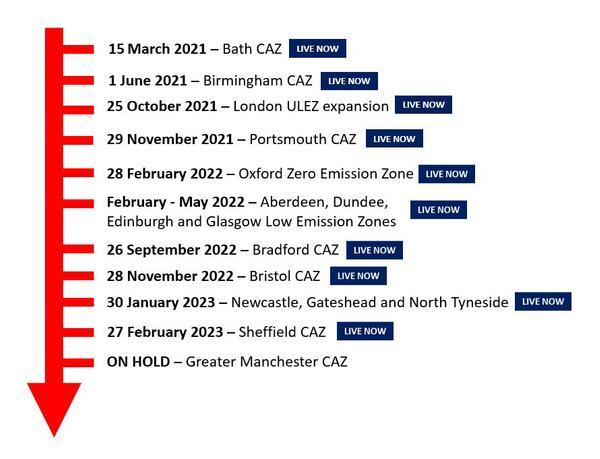
Where are the Clean Air & other zones?
(to view a key, please press the expand icon to the top left hand side of the map)
Bristol
Small CAZ D started on 28 November 2022.
Over 71% of vehicles travelling into Bristol already meet the zone's emission standards. Only older and more polluting vehicles will be charged.
In the coming years, this percentage should increase even more as more people take advantage of the available financial support to switch to a cleaner vehicle or a different mode of transport
The long-term ambition is to transform Bristol’s transport network, with new road layouts that create cleaner air and better bus, walking and cycling journeys, alongside ongoing plans for a mass transit public transport system.
Visit Clean Air for Bristol for more information.
Greater Manchester
As part of the Greater Manchester Clean Air Plan to ‘tackle nitrogen dioxide exceedances’ Bolton, Bury, Oldham, Rochdale, Stockport, Tameside, Trafford, Wigan, and the cities of Manchester and Salford have announced proposals for a joint charging clean air zone covering the whole of Greater Manchester.
The Greater Manchester CAZ plans are currently on hold.
In January 2023, government asked Greater Manchester for additional evidence to support its case for a non-charging Clean Air Plan.
It has submitted some of the evidence requested and will submit further evidence, which requires detailed modelling, at the end of June 2023.
It has an investment-led, non-charging Clean Air Plan aiming to tackle air pollution in a way that protects jobs, livelihoods and businesses.
Greater Manchester leaders believe that this is possible without the need for a charging Clean Air Zone.
---------------------------------------------------------------
Greater Manchester has been directed by government to introduce a Clean Air Zone. It has asked for more than £150m government funding for local businesses to move to cleaner vehicles and avoid paying a daily charge.
Eligible van, heavy goods vehicle, bus, coach, taxi, private hire vehicle or minibus owners in Greater Manchester would be able to apply for financial support. This would be as a lump sum grant or contribution towards vehicle financing. Owners or registered keepers of non-compliant vehicles in Greater Manchester can use this funding to move to cleaner, compliant vehicles and not have to pay a daily charge.
The following daily charges were proposed for non-compliant commercial vehicles during public consultation:
| Vehicles | Proposed daily charges |
| Buses, coaches and Heavy Good Vehicles (HGV) | £60 |
| Taxis and private hire vehicles | £7.50 |
| Light Goods Vehicles (LGV) such as vans and minibuses | £10 (temporary exemption until 2023) |
Visit: Clean Air Greater Manchester (cleanairgm.com) for more information.
Liverpool
The Clean Air Zones study in Liverpool is still in development. Sefton MBC is also considering options around how best to improve air quality within the borough. The Combined Authority is continuing to actively support Liverpool City Council with the development of options and potential delivery as part of the process of developing an outline business case submission to Defra.
More information on Liverpool's air quality plans is available on the Liverpool City Region website.
Newcastle, Gateshead and North Tyneside
This CAZ C now applies charges for non-compliant taxis, buses and HGVs (from 30 January 2023) and non-compliant vans will face charges to enter the CAZ from July 2023.
For more information visit BREATHE Clean Air (breathe-cleanair.com)
The final proposals included:
- Grants for people and businesses affected by a Clean Air Zone charge to help them upgrade their vehicles.
- A sunset or grace period where some vehicles wouldn’t be charged straight away as well as some exemptions for vehicles that wouldn’t be charged at all.
- A charging Clean Air Zone focussed on Newcastle city centre, affecting non-compliant buses, coaches, taxis (Hackney Carriages and private hire vehicles), heavy goods vehicles and vans, to be enforced from 2021.
- Changes to the road layout on the Central Motorway to prevent traffic from merging on and off the slip road between the New Bridge Street and Swan House junctions.
- Lane restrictions on the Tyne Bridge and its approaches, including on the Central Motorway. This will be done as part of measures to improve air quality but councils are also asking government for £40m funding to enable essential maintenance works to be carried out at the same time to minimise the need for further disruption.
- Changes to the local roads network in Newcastle and Gateshead to reflect the Tyne Bridge changes and ensure public transport can run reliably.
- New delivery hubs for goods vehicles outside of the charging zone, from where last-mile deliveries can be made by electric vehicle or cargo bike.
- Ambitious funding bids to the Transforming Cities Fund and Clean Air Fund for investment in public transport, walking and cycling routes.
- A major communications campaign to ensure people are aware of the measures, including the support that will be offered, and to encourage people to change their travel behaviour, switching to public transport, walking or cycling where it is possible for them to do so
Portsmouth
Portsmouth City Council have implemented a CAZ B which went live in on 29 November 2021.
Heavy Goods Vehicles (HGVs), buses and coaches, taxis and private hire vehicles (PHVs) will all be charged if they do not meet Euro 6 diesel or Euro 4 petrol standards. Non compliant HGVs, buses and coaches will pay £50 per day, and non compliant PHVs will be charged £10 per day for driving through the zone.
For more information visit: Charging Clean Air Zone - Travel Portsmouth
Sheffield
A CAZ C went live on Monday 27 February 2023. Charges apply to Taxis, Private Hire, Buses, Coaches, HGVs and LCVs.
This zone forms part of the city’s Clean Air Strategy and longer term ambitions to tackle climate and environmental emergencies.
Financial assistance is available - see the Clean Air Sheffield link below.
| Vehicle | Proposed daily charge |
| Coaches, buses and HGVs | £50 |
| LGVs and Taxis | £10 |
Larger campervans and motorhomes can apply for a discounted rate, reducing the charge amount to £10.
Payments can be made 6 days before, on the day of travel or by 11:59pm on the sixth day after driving in the zone.
For more informtion visit the Clean Air Sheffield website.
Birmingham
CAZ D from 1 June 2021
Non compliance charges apply to all vehicles types
| Vehicle | Daily charge |
| HGVs | £50 |
| Cars & LCVs | £8 |
To avoid paying the Clean Air Zone charge you may want to consider upgrading your vehicle.
You can find out everything you need to know about Birmingham’s CAZ using the link below. This includes details about local exemptions as well as access to the financial incentives scheme designed to help those regularly affected by charges to upgrade their vehicles.
Visit Welcome to Brum Breathes for more information
Bradford
CAZ C – launched 26 September 2022.
Exemptions and grants are still available.
For further information regarding the Bradford Clean Air Zone please go to the Breathe Better Bradford website.
Leicester
In a letter to Leicester City Council, the Government’s Department for Environment Food and Rural Affairs (Defra) has confirmed that a proposed ‘Clean Air Zone’ for buses and taxis within the inner ring road is no longer needed for Leicester to meet targets to drive down air pollution.
Figures collected from a network of air quality monitoring stations at five key locations across the city in 2020 – show that Leicester is meeting all current EU air quality objectives, including for nitrogen dioxide (NO2) for the first time since monitoring began over 20 years ago.
More information on the Leicester City Council website (leicester.gov.uk)
London
The Ultra Low Emission Zone (ULEZ) will from 29 August 2023 cover all London boroughs, but not including the M25. The ULEZ was introduced in April 2019, replacing the T-charge and operating within the congestion charge area and in 2021 the scheme was extended to cover all areas within the North and South Circular roads.
The scheme operates 24 hours a day, 7 days a week, every day of the year, except Christmas Day (25 December).
A daily charge of £12.50 applies to the following vehicles that do not meet the ULEZ emissions standards. Typically this is petrol vehicles over 16 years old and diesel vehicles over 6 years old.
- Cars, motorcycles, vans and specialist vehicles (up to and including 3.5 tonnes) and minibuses (up to and including 5 tonnes)
Lorries, vans or specialist heavy vehicles (over 3.5 tonnes) and buses, minibuses and coaches (over 5 tonnes) do not need to pay the ULEZ charge. They will need to pay the LEZ charge if they do not meet the LEZ emissions standard.
The Mayor has committed to help charities, small businesses, disabled people and Londoners on lower incomes adapt to the potential London-wide ULEZ, with as big a scrappage scheme as is feasible to help motorists in outer London scrap their older, more polluting vehicles and instead switch to cleaner forms of transport, use a car club vehicle or purchase newer, cleaner models that are ULEZ-compliant. He is also calling on the Government to provide extra support for a scrappage scheme in London – like they have done for other cities around the country.
Further details on the ULEZ including a vehicle checker are available on the Transport for London website.
Oxford
A pilot Zero Emission Zone (ZEZ) launched 28 February 2022.
This differs to a Clean Air Zone as only zero emission vehicles can enter the zone and not pay a fee.
The ZEZ has two phases – initially the zone is a small area in Oxford City Centre which will later be expanded to a wider area.
Charges will apply from 7 am to 7 pm, seven days a week, all year round. The daily charge covers the entire day, so a vehicle can enter and be used within the area on multiple occasions each day.
Charges will start at £2 a day for an Ultra Low Emission Vehicle, £4 for a Low Emission vehicle and £10 for all other vehicles. These costs will rise in August 2025 to £4, £8 and £20 respectively. Further information on the charges and the ZEZ can be found here.
More detailed information about the Oxford plans is available on the Council’s website.
Scotland (Aberdeen, Dundee, Edinburgh and Glasgow)
Aberdeen, Dundee, Edinburgh and Glasgow each introduced a Low Emission Zone (LEZ) between February 2022 and May 2022.
These LEZs differ to the CAZs – a PCN is payable by the vehicle’s registered keeper when a non-compliant vehicle enters the LEZ, there is no option to pay a charge unlike the CAZs.
Read more about the plans in Scotland on the Low Emission Zones Scotland website.
FREE resources to help members to promote awareness of Clean Air Zones
BVRLA members can access the suite of FREE social graphics, digital web banners and printed material in the Communications Toolkit by logging into their BVRLA web account.
This will support members' communications to customers and can be co-branded carrying member's own call to action and company logo.
The www.cleanairzones.co.uk is registered by the BVRLA and is directed to the association's Clean Air Zones information - providing a useful information resource for members and their customers.
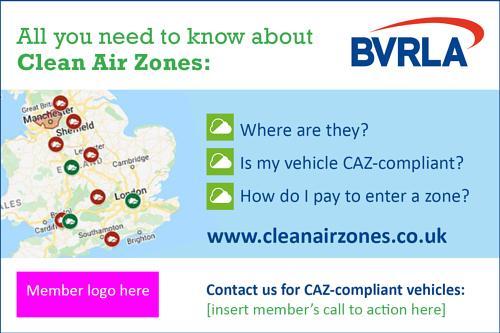
Voice of the Industry
See More...News and Guidance
See more...

